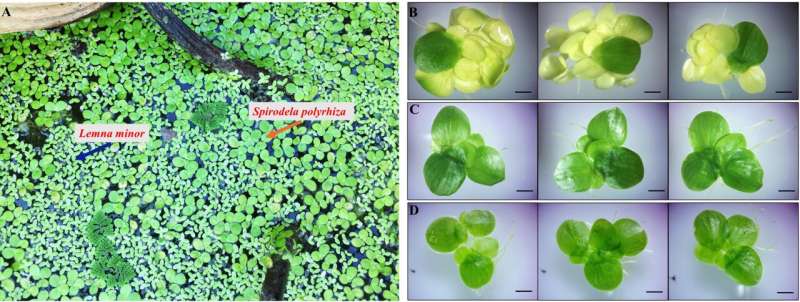This article has been reviewed according to Science X's editorial process and policies. Editors have highlighted the following attributes while ensuring the content's credibility:
fact-checked
peer-reviewed publication
trusted source
proofread
Greater duckweed shows metabolic flexibility during trophic transition

Duckweeds, a group of fast-growing aquatic plants, are good candidates for bioenergy production and CO2 capture because of their simple structure, fast growth rate and high starch content. At present, duckweed cultivation mainly focuses on a photoautotrophic mode, which is not optimal for a high growth rate and biomass accumulation, and is not the best trophic mode for duckweed industrial applications.
Previous research has shown that duckweed is not an obligate photoautotrophic plant, and it can thrive on a variety of exogenous organic carbons in the presence or absence of light (photoheterotrophic, mixotrophic, and heterotrophic). Mixotrophic duckweed benefits from both photosynthesis and respiration metabolic pathways and grows much faster than its photoautotrophic and heterotrophic counterparts alone or in combination. This indicates that there may be a synergistic effect and "crosstalk" between chloroplasts (photosynthesis) and mitochondria (respiration). The molecular mechanism underlying such a metabolic pathway remains largely unknown.
Recently, a research team led by Prof. Hou Hongwei from the Institute of Hydrobiology (IHB) of the Chinese Academy of Sciences revealed the molecular mechanism of mixotrophic growth. This study was published in New Phytologist.
The researchers used tools of biochemistry, physiology, and multi-omics to dissect the metabolic mechanisms of mixotrophic duckweed. They discovered that compared with those of photoautotrophic duckweed, the CO2 concentrating mechanism and photosynthetic pathways of mixotrophic duckweed are significantly inhibited.
Using proteomic and metabolomic techniques, they found that the respiration pathway of mixotrophic duckweed was found to be significantly enhanced (glycolysis, tricarboxylic acid cycle, pentose phosphate pathway, and fermentation), which caused the increase in intracellular CO2 concentration and the decrease in O2 concentration.
These results led to the inhibition of photorespiration and oxidative damage in mixotrophic duckweed, reducing the massive consumption of material and energy and achieving maximum biomass accumulation.
Duckweed is a potential candidate for bioenergy and food production. This study lays the foundation for exploiting the metabolic switch in duckweed to enhance bioenergy and food output.
More information: Zuoliang Sun et al, Metabolic flexibility during a trophic transition reveals the phenotypic plasticity of greater duckweed (Spirodela polyrhiza 7498), New Phytologist (2023). DOI: 10.1111/nph.18844
Journal information: New Phytologist
Provided by Chinese Academy of Sciences


















